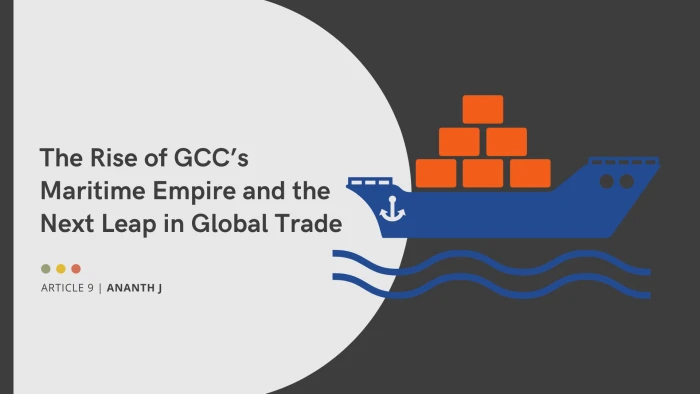The Gulf Cooperation Council (GCC) has firmly established itself as a global maritime powerhouse, leveraging its strategic geographic location, world-class infrastructure, and visionary investments to command a leading role in international trade. As global trade patterns evolve and competition intensifies, the GCC’s maritime sector continues to set new benchmarks for efficiency, resilience, and innovation, driving billions in trade value through the region and reinforcing its status as a preferred gateway for global commerce.
So, what exactly has fueled this meteoric rise, and what comes next for a region redefining global shipping? Let’s explore!
The Making of a Maritime Leader
The evolution of GCC ports is deeply rooted in the region’s transformation from pre-oil trading hubs to modern economic powerhouses. Historically, Gulf ports such as Dubai and Muscat served as vital centers for regional and international trade, connecting Asia, Africa, and Europe through the exchange of goods like textiles and spices. The discovery of oil in the early 20th century catalyzed rapid modernization, with oil revenues fueling significant investments in port infrastructure and logistics.
In recent years, the GCC’s maritime sector has achieved global recognition for its efficiency and innovation. As of 2024, ten GCC ports were ranked among the world’s top 70 most efficient, a distinction based on a comprehensive assessment of 405 global ports. This recognition underscores the region’s sustained focus on operational excellence and strategic investment.
(a) Dubai: Setting the Global Standard
Dubai’s Jebel Ali Port stands as a beacon of best-in-class performance. In the first half of 2024 alone, the port handled a record-breaking 7.3 million TEUs, marking a 3.9% year-over-year increase. Jebel Ali is the largest man-made harbor globally and consistently ranks among the top 10 busiest container ports worldwide. Its sustained growth trajectory continues to exceed market expectations, positioning Dubai as an indispensable link in global supply chains that connect Asia, Europe, and Africa.
(b) Qatar’s Strategic Leap
Qatar’s $7.4 billion investment in Hamad Port has fundamentally reshaped regional trade dynamics since its launch in 2017. With a final capacity target of 7.5 million TEUs, Hamad Port has significantly strengthened intra-GCC trade flows, reduced external dependencies, and enhanced supply chain resilience. Strategic partnerships with international shipping lines further demonstrate Qatar’s commitment to raising the bar for market competitiveness.
(c) Saudi Arabia’s Vision 2030: Transformational Maritime Investment
Saudi Arabia’s Vision 2030 has ushered in a new era of maritime infrastructure development. The Kingdom recently awarded a $1 billion contract for the Oxagon port within the NEOM mega-city, with over $2 billion invested and a new terminal opening planned for 2025.
King Abdullah Port has emerged as a leader in Red Sea trade, while the Saudi warehousing sector is projected to reach $13.2 billion by 2030, growing at a 4.5% CAGR. These investments create substantial competitive advantages, particularly in Red Sea trade routes and partnerships with key Asian markets.
The GCC’s maritime vision is anchored in a commitment to infrastructure excellence, technological innovation, and economic diversification. The region’s ports are not only expanding their physical capacity but also integrating advanced technologies such as AI-driven logistics, smart port solutions, and digital supply chain management.
These initiatives are designed to enhance operational efficiency, reduce costs, and improve service delivery.
Economic Muscle Behind the Maritime Might
Substantial investments are being channeled into port expansions, terminal upgrades, and logistics integration. For example, Saudi Arabia’s $170.5 million expansion of Jeddah Islamic Port and $1.87 billion upgrade of King Abdulaziz Port are part of a broader strategy to position the Kingdom as a global logistics hub. Qatar and Oman are similarly investing in port infrastructure and digital innovation to attract foreign investment and integrate more effectively into global trade networks.
The financial performance of the GCC’s maritime sector is robust, with nonhydrocarbon activity demonstrating strong growth amid comprehensive economic reforms. The sector’s contributions to GDP, employment, and economic resilience are significant, supporting the region’s transition toward a diversified, knowledge-based economy.
Why the World Moves Through the Gulf
The GCC’s commanding position in global maritime trade is underpinned by several key factors:
(a) Geographic Positioning: The region’s location at the crossroads of major trade routes connecting Asia, Europe, and Africa provides a natural advantage for facilitating international trade and serving as a transshipment hub.
(b) Infrastructure Quality: Heavy investments in port infrastructure, logistics, and free trade zones have enabled the GCC to handle large cargo volumes efficiently. Integration of shore power systems and low-emission zones across major facilities further enhances sustainability.
(c) Operational Efficiency: Consistent ranking among the world’s top-tier ports reflects the region’s focus on best-in-class performance and continuous improvement.
(d) Economic Integration: Seamless intra-GCC trade facilitation and economic policies, including free trade agreements, have bolstered the region’s position as a key player in global trade.
(e) Technological Advancements: Adoption of smart port technologies, AI, and digital transformation in supply chain management positions the GCC as a leader in maritime innovation.
(d) Cost Competitiveness: The region’s cost-effective operations attract global shipping lines and businesses, reinforcing its status as a preferred trade gateway.
The GCC’s maritime sector is a cornerstone of the region’s economic diversification strategy. Investments in port infrastructure and logistics have contributed to economic resilience, job creation, and GDP growth. The sector’s ability to withstand external shocks, such as financial crises and geopolitical tensions, demonstrates its marine economic resilience and underpins sustainable, high-quality development
Sailing Ahead: The Next Wave of Maritime Excellence
With such strong foundations in place, here’s what the future demands for GCC maritime leadership to endure and expand:
(a) Continued Infrastructure Investment: Sustain and expand investments in port infrastructure, logistics, and supporting facilities to accommodate future trade growth and technological advancements.
(b) Operational Efficiency Improvements: Implement best practices, automation, and digital solutions to further enhance port efficiency and reduce turnaround times.
(c) Strategic Partnership Development: Foster deeper partnerships with international shipping lines, logistics providers, and technology firms to strengthen global connectivity and market reach.
(d) Technology Integration and Sustainability Initiatives: Accelerate the adoption of smart port technologies, AI-driven logistics, and green initiatives to ensure environmental sustainability and operational agility.
(e) Economic Diversification and Resilience: Leverage maritime sector growth to support broader economic diversification goals, create new employment opportunities, and enhance the region’s resilience to external shocks.
(f) Regional Cooperation and Policy Alignment: Promote greater intra-GCC collaboration and policy harmonization to facilitate seamless trade flows and maximize collective competitive advantages.
The GCC’s ascent to maritime excellence is the result of decades of strategic vision, substantial investment, and unwavering operational discipline. By securing ten positions among the world’s top 70 most efficient terminals, the region has set a new global benchmark for port performance and supply chain integration. The GCC’s ports are not only gateways for billions in trade value but also engines of economic diversification, resilience, and innovation. As the region continues to invest in infrastructure, technology, and sustainability, its maritime sector is poised to maintain and expand its commanding position in global trade. The collective achievements of the GCC’s maritime industry benefit all stakeholders, governments, businesses, and communities, ensuring that the region remains the preferred gateway for international commerce well into the future.
Sources:
https://www.porttechnology.org/news/qatar_opens_7-4_billion_hamad_port_for_global_trade/
https://www.middleeastbriefing.com/news/gcc-ports-key-pillars-of-global-trade-and-maritime-connectivity/#:~:
https://www.numberanalytics.com/blog/modernization-in-gulf-states-history#:~:
https://fastcompanyme.com/news/how-gccs-ports-and-expanding-fleets-are-shaping-the-future-of-maritime-trade/#:~:


